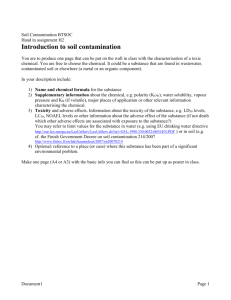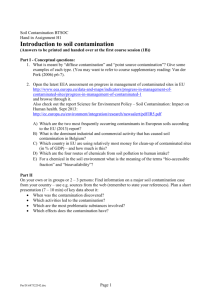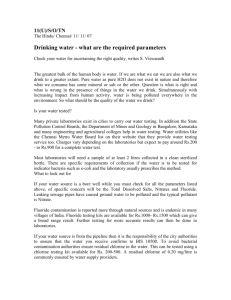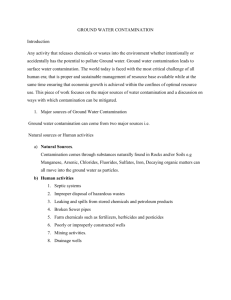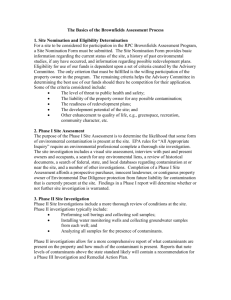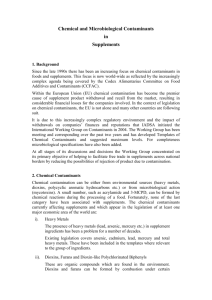Risk Management Decisions
advertisement
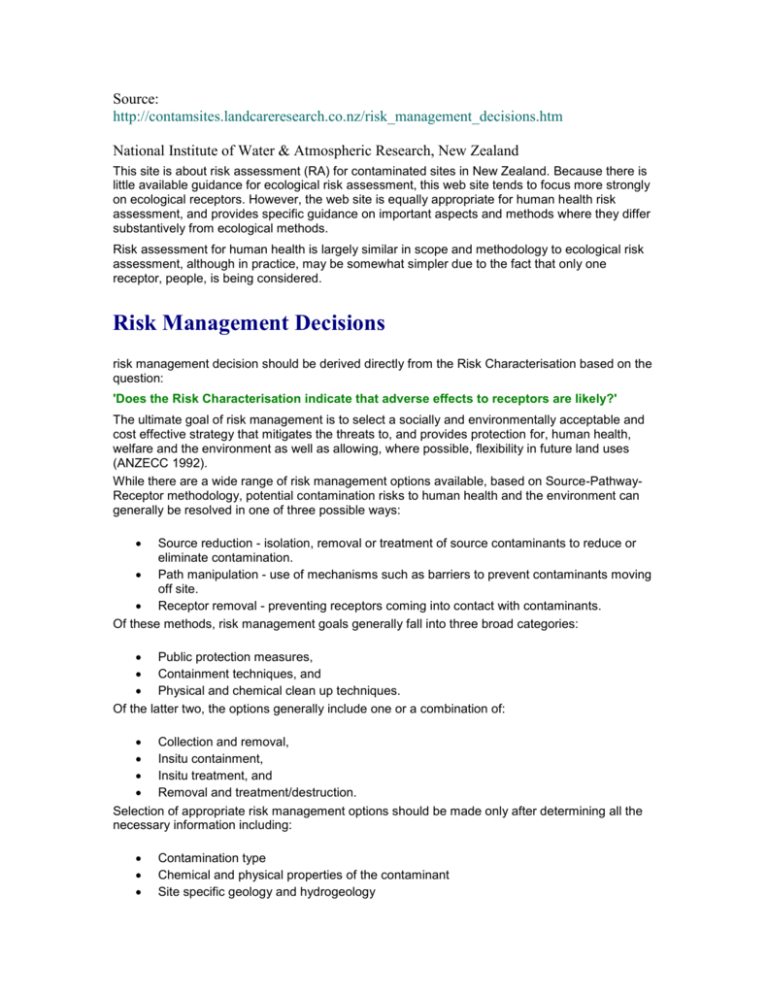
Source: http://contamsites.landcareresearch.co.nz/risk_management_decisions.htm National Institute of Water & Atmospheric Research, New Zealand This site is about risk assessment (RA) for contaminated sites in New Zealand. Because there is little available guidance for ecological risk assessment, this web site tends to focus more strongly on ecological receptors. However, the web site is equally appropriate for human health risk assessment, and provides specific guidance on important aspects and methods where they differ substantively from ecological methods. Risk assessment for human health is largely similar in scope and methodology to ecological risk assessment, although in practice, may be somewhat simpler due to the fact that only one receptor, people, is being considered. Risk Management Decisions risk management decision should be derived directly from the Risk Characterisation based on the question: 'Does the Risk Characterisation indicate that adverse effects to receptors are likely?' The ultimate goal of risk management is to select a socially and environmentally acceptable and cost effective strategy that mitigates the threats to, and provides protection for, human health, welfare and the environment as well as allowing, where possible, flexibility in future land uses (ANZECC 1992). While there are a wide range of risk management options available, based on Source-PathwayReceptor methodology, potential contamination risks to human health and the environment can generally be resolved in one of three possible ways: Source reduction - isolation, removal or treatment of source contaminants to reduce or eliminate contamination. Path manipulation - use of mechanisms such as barriers to prevent contaminants moving off site. Receptor removal - preventing receptors coming into contact with contaminants. Of these methods, risk management goals generally fall into three broad categories: Public protection measures, Containment techniques, and Physical and chemical clean up techniques. Of the latter two, the options generally include one or a combination of: Collection and removal, Insitu containment, Insitu treatment, and Removal and treatment/destruction. Selection of appropriate risk management options should be made only after determining all the necessary information including: Contamination type Chemical and physical properties of the contaminant Site specific geology and hydrogeology Extent (depth, width, length, speed) of contamination Clean-up targets - how clean will it be, what are the likely future land uses Effectiveness of clean-up technology - all contaminants simultaneously or different methods for different contaminants, characteristics of mechanism used Suitable disposal of residuals from remediation process Likely costs to achieve clean-up targets Public protection measures: Reduce site access - particularly for physical hazard and air emissions. Source prevention/reduction - preventing further contamination. Minimise exposure pathways - preventing movement of contaminants or use of a contaminated area Containment Technologies: These methods principally involve mechanisms of containment without the excavation of material to prevent migration of contamination and eliminate exposure pathways. Effective containment can be a comparatively cheap option but ongoing site management and information issues must be addressed. Surface capping - clean cover technology, must address: o Safe permanent barrier o Minimise toxicity o Control lateral movement of infiltrated rainfall o Prevent/reduce infiltrating rainfall o Control upward migration of contaminants/gases o Resist subsidence/settlement/erosion/slope instability o Prevent/reduce combustion risks o Ongoing maintenance requirements. Horizontal subsurface barriers - jet grouting, chemical grouting, claquage grouting Vertical barriers - slurry trench cutoff walls, grout curtains, sheet piling, high density polyethylene (HDPE), other impermeable or semi-permeable liner material. Clean-up Technologies - Soil: Thermal destruction/incineration Thermal desorption Solidification / stabilisation Vitrification Soil vapour extraction / soil venting Steam extraction Dehalogenation Chemical oxidation Soil flushing Soil washing Solvent extraction Bioremediation Insitu bioremediation - bioaugmentation or biostimulation Landfarming Biopiles / biospheres Excavation & disposal Soil mixing Natural attenuation Degradation Clean-up Technologies - Groundwater/Surface water: Containment Air stripping Air sparging Adsorption Spray irrigation Biofilm Chemical oxidation / UV Dehalogenation Insitu bioremediation Free product recovery - pump, skim, recovery trenches/drains Precipitation Ion exchange Membrane filtration Pump & treatment - pH adjustment, chemical addition, settling, filtration, ion exchange, electrodialysis, reverse osmosis Pump & disposal Natural attenuation Degradation At all tiers, risk management decisions should take into account not only the effect of continued exposure of the receptor to a contaminant, but also the potential effects of any remedial action proposed. Risk management decision tasks Making a Risk Management Decision entails deciding which of a variety of options are the most appropriate to manage the site. These options typically include: do nothing monitoring prevention remediation decommissioning. Other factors that may affect a risk management decision will require consideration. These may include: policies and objectives of the relevant regulatory agency community expectations perceived risk costs of remedial or other actions benefit of those actions. The Australian and New Zealand Guidelines for the assessment and management of contaminated sites provides a good discussion of factors likely to affect a risk management decision. Documentation At each stage of the RA, the process should be documented. This will most likely involve the collation of the information into a report. The most important components of reporting include outlining the objectives of the study, the methods used, and results obtained, the uncertainties and assumptions on which these were based, the risk characterisation conclusions, and the risk management decisions taken. The report should provide interested parties with sufficient information to understand why each decision was made throughout the process. You may choose to prepare a report at each Tier of RA undertaken, or generate mini-reports for each task, to be collated into a site report to inform the risk management decision. There are a variety of reasons for documenting the RA process, including to: describe how the RA was conducted provide evidence of a systematic approach to each aspect of the RA provide justification for the methods used and decisions taken including the risk management options chosen provide an accountability mechanism continuing monitoring and review of risk management actions share and communicate information. Tier 1 documentation may include a technical report outlining the basic site information obtained during Initiation and Tier 1 investigations, including contaminant concentrations, potential transport mechanisms and pathways, potential receptors, and benchmark criteria used to determine the acceptance levels for on-site contamination. This report should also outline the Risk Characterisation conclusions, the risk management decision made and, where appropriate, the terms of reference for the Tier 2 RA.

